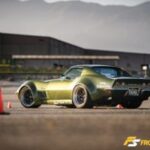The 1979 Corvette often finds itself at the heart of discussions among classic car enthusiasts, particularly when evaluating C3 Corvettes as investments. The debate frequently centers around the age-old contrast: rubber bumpers versus chrome, and the ever-desirable horsepower figures. Interestingly, the sheer number of high-mileage 1979 Corvettes available today suggests that this model year was truly built for driving and enjoyment.
While even a fully optioned 1979 Corvette might not reach the investment heights of a fire-breathing 1969 427 Vette, it’s important to remember these cars were designed for different eras and different drivers. This naturally leads to the pertinent question: Does the 1979 Corvette hold investment potential moving forward?
The answer is likely yes. However, realizing maximum value might hinge on specific option combinations. A 1979 C3 Corvette equipped with the L82 engine (14,516 produced), the Close Ratio 4-Speed manual transmission (M21 – 4,062 produced), Gymkhana Suspension (FE7 – 12,321 produced), Spoilers (D80 – 6,853 produced), Glass Roof Panels (CC1 – 14,480 produced), Aluminum Wheels (N90 – 33,741 produced), AM-FM Cassette player (UN3 – 12,110 produced), and Dual Rear Speakers (U81 – 3,405 produced) represents a particularly rare configuration if all these options were combined. Low-mileage examples with such a combination could potentially command prices in the $40,000 to $50,000 range in today’s market.
Production volume is often cited as a deterrent to appreciating value. However, consider the 1965 Ford Mustang. Ford produced around half a million of these iconic pony cars, yet even with such high numbers, all 1965 Mustangs are desirable. The truly exceptional examples are those boasting rare options, but even the six-cylinder models are sought after. Compared to the Mustang, the 1979 Corvette’s production numbers are relatively modest. Both were incredibly popular cars in their respective years, with the 1979 Corvette being arguably the hottest selling American car of its time, often sold above the sticker price.
Looking back over four decades later, some argue that the 1979 Corvette marked the true end of the C3 era in spirit. After 1979, the high-output L82 engine was no longer available with a four-speed manual transmission; the 1980-1982 C3 models only offered the manual transmission with the less powerful L48 engine.
One thing remains undeniable: 1979 Corvettes were made to be driven, and many continue to be enjoyed on the roads today. The discussion about their investment potential is sure to continue, fueled by their unique place in Corvette history.
